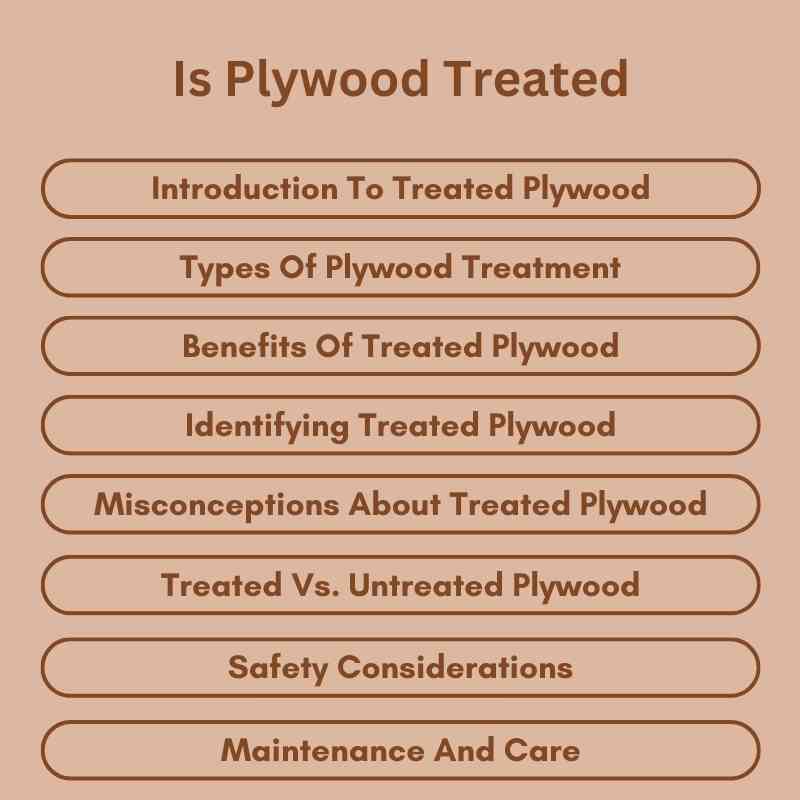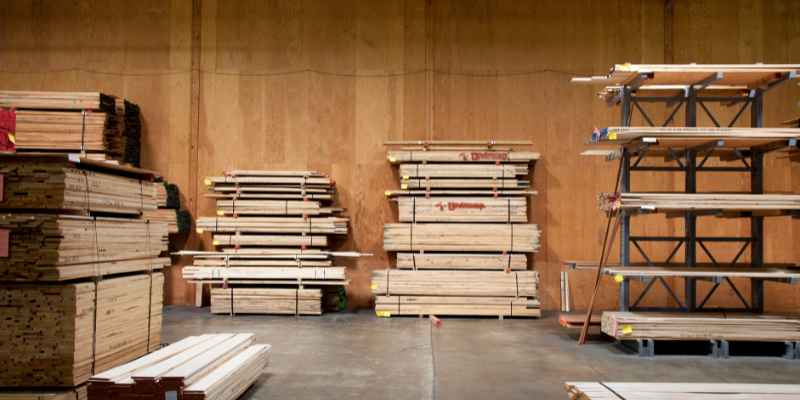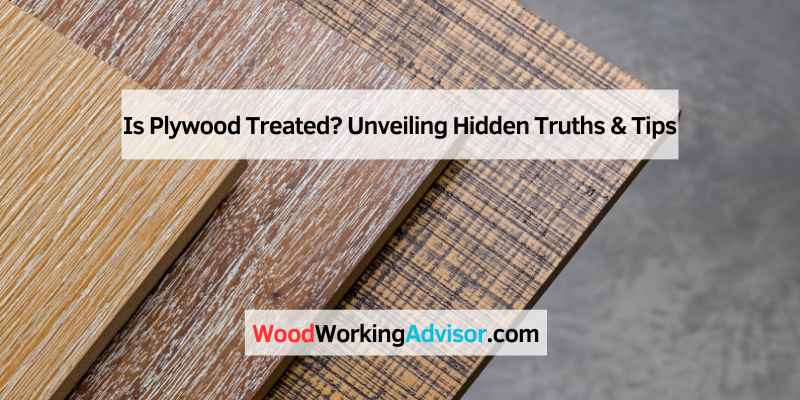Plywood can be treated, but not all types are. Treated plywood undergoes a process to resist moisture and insects.
Plywood is a versatile building material made from thin layers of wood veneer. It offers strength and stability, making it popular for various construction projects. Treated plywood provides added protection against the elements, ideal for outdoor use. Many homeowners and contractors prefer treated plywood for decks, fences, and other structures exposed to moisture.
Understanding the treatment process and its benefits can help you choose the right plywood for your needs. Whether you’re building a shed or renovating your home, selecting the appropriate plywood type is crucial for durability and longevity. Make informed decisions to ensure your projects stand the test of time.
Introduction To Treated Plywood
Plywood is a versatile material used in many applications. It is often found in furniture, flooring, and construction. Treated plywood is specifically designed for outdoor use. It withstands moisture and resists pests effectively.
Common uses of treated plywood include:
- Decking and patios
- Fencing and garden structures
- Exterior walls and roofing
- Furniture for outdoor settings
Treated means the plywood has gone through a special process. Chemicals are added to protect it from water and insects. This treatment helps the plywood last longer, especially in harsh conditions.
Types Of Plywood Treatment
Plywood can be treated using various methods. Pressure treatment is a popular technique. This method forces preservatives deep into the wood. It helps to protect against rot, insects, and moisture.
Different chemical preservatives are used in this process. Common ones include:
| Preservative | Benefits |
|---|---|
| Chromated Copper Arsenate (CCA) | Effective against decay and insects. |
| Alkaline Copper Quaternary (ACQ) | Environmentally friendly and non-toxic. |
| Micronized Copper Azole (MCA) | Good for outdoor use and resistant to mold. |
Choosing the right treatment is crucial. It ensures the plywood lasts longer and performs well.

Benefits Of Treated Plywood
Treated plywood offers enhanced durability. It withstands harsh conditions and lasts longer. The treatment process protects the wood from decay.
Resistance to elements is another key benefit. Treated plywood can handle moisture and pests. This makes it ideal for outdoor projects.
Common uses include decks, fences, and sheds. Homeowners prefer treated plywood for its reliability. It provides peace of mind in various weather conditions.
Identifying Treated Plywood
Identifying treated plywood can be easy with some basic tips. Start with a visual inspection. Look for color variations. Treated plywood often has a greenish tint. This helps indicate it has been treated.
Next, check for labeling and stamps. Treated plywood usually has a stamp. This stamp shows it meets safety standards. Look for terms like “ACQ” or “CCA.” These indicate the type of treatment used.
Finally, feel the surface. Treated plywood may feel smoother or shinier than untreated types. Use these tips to help you identify treated plywood easily.
Misconceptions About Treated Plywood
Many people think treated plywood is waterproof. This is not true. Treated plywood is resistant to moisture but not completely waterproof.
Another common myth is that treated plywood is safe for all indoor uses. Some chemicals used in treatment can be harmful indoors.
People often believe treated plywood lasts forever. While it is durable, it can still degrade over time. Proper care is important.
Some assume that all treated plywood looks the same. In reality, there are different types with various appearances.
Finally, some think treated plywood is only for outdoor projects. It can also be used indoors, depending on the treatment type.
Treated Vs. Untreated Plywood
Treated plywood is designed to resist moisture, insects, and decay. This makes it ideal for outdoor projects. Untreated plywood, on the other hand, is less durable. It is best for indoor uses.
Here’s a quick comparison of their properties:
| Property | Treated Plywood | Untreated Plywood |
|---|---|---|
| Moisture Resistance | High | Low |
| Insect Resistance | High | Low |
| Price | Higher | Lower |
| Common Uses | Outdoor projects | Indoor projects |
Choosing the right type for your project depends on the environment. Use treated plywood for areas exposed to the elements. Select untreated plywood for dry, indoor spaces.
Safety Considerations
Handling treated plywood requires special care. Always wear gloves and a mask. Use safety glasses to protect your eyes. Avoid contact with skin to prevent irritation. Store treated plywood in a dry area. Keep it away from children and pets.
Disposing of treated plywood must follow local regulations. Do not burn treated plywood. Burning can release harmful chemicals. Instead, take it to a designated disposal site. Always check with local authorities for proper disposal methods.
Maintenance And Care
Taking care of plywood helps it last longer. Regularly clean the surface with a soft cloth. Avoid using harsh chemicals that can damage the wood. Check for signs of wear or damage often. If you see any issues, fix them right away.
Applying a protective finish can help seal the wood. This keeps moisture away and prevents warping. Ensure the plywood is stored in a dry place. Avoid placing it in areas with high humidity. This will protect it from mold and other problems.
Consider using coasters and mats to protect surfaces. This prevents scratches and stains. Regular maintenance makes your plywood look great and last longer.

Frequently Asked Questions
Is Plywood Treated For Outdoor Use?
Yes, plywood can be treated for outdoor use. Treated plywood is specially designed to resist moisture, decay, and pests. This type of plywood is often coated with chemicals that enhance its durability. It’s ideal for outdoor projects like decks and sheds, ensuring long-lasting performance against the elements.
What Chemicals Are Used In Plywood Treatment?
Common chemicals used in plywood treatment include copper-based preservatives and borate compounds. These help protect against mold, rot, and insects. The treatment process involves pressure-impregnating these chemicals into the wood. This makes the plywood more resilient and extends its lifespan when used in various applications.
How Long Does Treated Plywood Last?
Treated plywood can last anywhere from 10 to 30 years. Its lifespan depends on factors like the environment and maintenance. Proper installation and regular care can significantly enhance durability. It’s essential to choose high-quality treated plywood for optimal longevity, especially in harsh conditions.
Can Untreated Plywood Be Used Outdoors?
Using untreated plywood outdoors is not recommended. It is prone to moisture damage, warping, and decay. If you must use it, ensure it is properly sealed and protected. However, treated plywood is always a better option for outdoor applications to ensure durability and safety.
Conclusion
Understanding whether plywood is treated is essential for making informed choices. Treated plywood offers enhanced durability and resistance to moisture and pests. It’s ideal for outdoor projects or environments prone to humidity. Always check for treatment specifications to ensure your plywood meets your needs for longevity and performance.
Choose wisely for lasting results.

